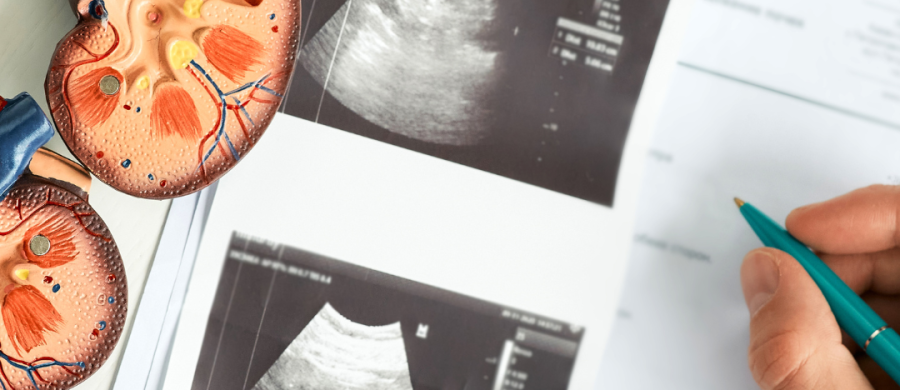Polycystic kidney disease (PKD) is a genetic disease characterized by the formation of fluid-filled cysts in the kidneys. These cysts can gradually replace healthy kidney tissue over time, leading to a decline in kidney function. PKD is one of the most common inherited diseases affecting the kidneys and can lead to various complications, including the development of chronic kidney disease (CKD), which can progress to its end stage (End stage renal disease, ESRD).
In about 90% of cases, patients have autosomal dominant polycystic kidney disease (ADPKD). This means that in the presence of 1 sick parent, the probability of children being born with ADPKD is 50%.
WHAT ARE THE SYMPTOMS OF POLYCYSTIC KIDNEY DISEASE?
In autosomal dominant polycystic kidney disease, the first symptoms usually appear around 30-40 years of age. In contrast, the autosomal recessive form manifests itself in childhood.
The most common symptoms include:
- Pain in the lumbar region due to the enlargement of the kidneys and the pressure exerted by the cysts.
- In the beginning, the blood pressure tends to be higher compared to the more advanced stages of the disease.
- Hematuria (blood in the urine). Polycystic kidneys are very susceptible to trauma and minor injury can lead to bleeding.
- Cysts can interfere with the normal flow of urine, increasing the risk of kidney stones.
- Urinary tract infections: Cysts can provide a breeding ground for bacteria, leading to recurrent infections.
- Fatigue, weakness, breathlessness
WHY DOES POLYCYSTIC KIDNEY DISEASE LEAD TO CHRONIC KIDNEY DISEASE?
Chronic kidney disease (CKD) is a progressive condition characterized by gradual loss of kidney function over time. The kidneys play a key role in filtering waste products and excess fluid from the blood, regulating electrolyte balance, and producing hormones that control blood pressure. As CKD progresses, these functions are impaired, leading to the accumulation of toxins in the body and disturbances in basic body processes.
The progression of polycystic kidney disease to chronic kidney disease results from the gradual and cumulative damage that the cysts cause to the kidney tissue over time. Several mechanisms contribute to the development of CKD in individuals with polycystic disease:
- Replacement of healthy kidney tissue by cysts.
- Cysts lead to reduced blood flow to the kidneys.
- Inflammation in the kidneys, as a result of which the healthy kidney tissue is replaced by connective tissue (fibrosis).
- Arterial hypertension, which is characteristic of polycystic kidney disease, further damages the kidney.
- Frequent urinary tract infections as well as infections of the cysts.
WHAT IS THE TREATMENT FOR POLYCYSTIC KIDNEY DISEASE?
Currently, there is no cure for polycystic kidney disease. The efforts of medical professionals are aimed at slowing the progression of the disease so as to preserve kidney function as much as possible and postpone the need for dialysis or transplantation.
Maintaining optimal blood pressure is a key aspect of polycystic kidney disease therapy. Angiotensin-converting enzyme (ACE) inhibitors or angiotensin II receptor blockers (ARBs) are the medications used.
In patients who are at risk of rapid disease progression, therapy with the medication tolvaptan is possible. Its use slows down the formation of cysts.
Other aspects of polycystic kidney disease therapy include:
- Appropriate diet
- Avoidance of contact sports due to risk of renal hemorrhages
- Symptomatic treatment of the pain caused by the enlarged kidneys
- Treatment of metabolic disorders
- Strict control of renal function by a nephrologist, regular imaging studies of the kidneys. Consultations with other specialists if necessary (cardiologist, endocrinologist, etc.)
WHEN IS HEMODIALYSIS OR KIDNEY TRANSPLANTATION NECESSARY?
Unfortunately, a large percentage of people with polycystic kidney disease must at some point begin dialysis treatment or consider a kidney transplant. This is necessary when reaching the end stage of chronic kidney disease, in which the kidneys have stopped functioning or their function is drastically reduced (glomerular filtration eGFR<15ml/min/1.73m2).
This condition is always accompanied by laboratory changes (high urea, creatinine, potassium and phosphates), as well as symptoms (itching, muscle cramps, nausea and vomiting, swelling of the legs and arms, back pain, often complete cessation of urine output, shortness of breath, insomnia).
Kidney transplantation is considered the best treatment option for patients who have reached an advanced stage of the disease. It is important to note that the procedure involves thorough patient assessment, preparation and finding a suitable donor, which takes time. After the surgery, immunosuppressive therapy is necessary, as well as strict monitoring of one’s health.
In cases where polycystic kidney disease progresses to end-stage kidney disease, dialysis (hemodialysis or peritoneal dialysis) must be started to help manage symptoms and maintain overall health. Dialysis is necessary while waiting for a transplant, or in cases where the patient is not a suitable candidate or does not wish to have a kidney transplant. The availability of different dialysis methods, as well as vacation dialysis centers, significantly reduces the limitations associated with regular procedures.









